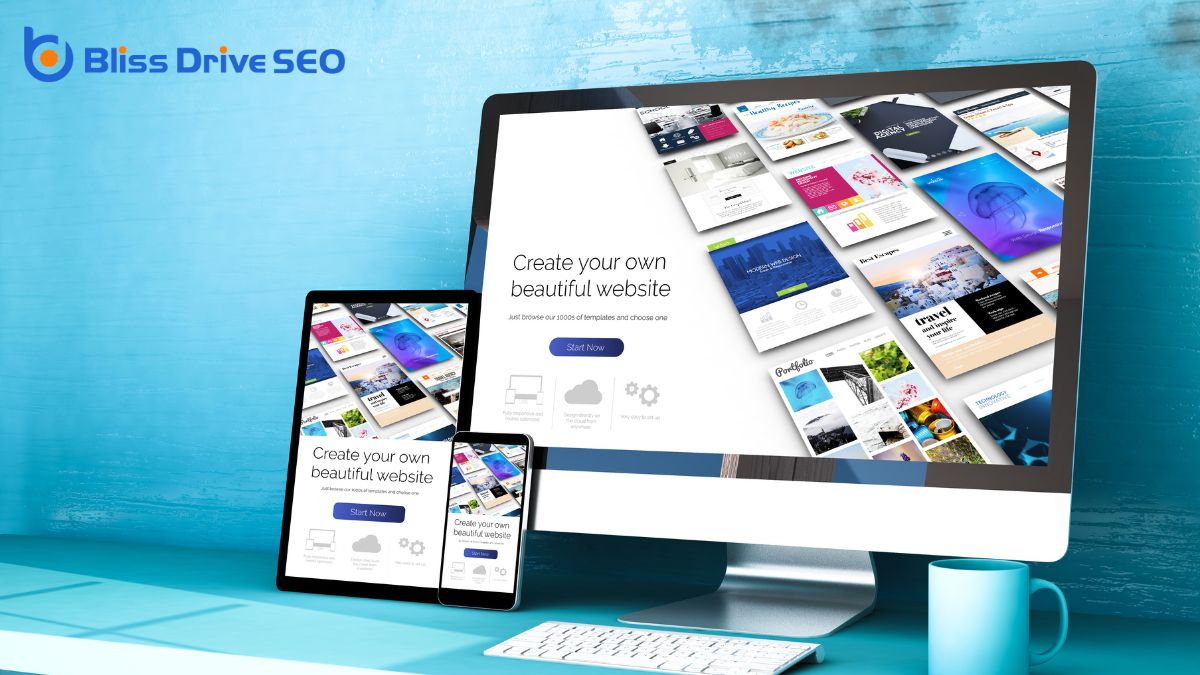Digital Marketing Services
Learn More About Us

When you think about web design, it's not just about creating a pretty website. You might wonder how a well-thought-out design can enhance user experience or reflect a brand's identity. It's more than aesthetics; it's about crafting a space where users can navigate easily and engage meaningfully. But how does web design influence e-commerce success or optimize your site for search engines? And what role does it play in digital marketing and content management? There are layers to web design that go beyond the surface, each serving a vital purpose in the digital landscape.

A key aspect of web design is enhancing user experience, as it directly influences how users interact with your site. When visitors land on your page, they should find it intuitive and easy to navigate. You want them to feel comfortable so they'll stay longer and explore more.
Focus on clear layouts, simple navigation, and fast load times. These elements make users more likely to engage with your content and return in the future.
Consider how you organize information. Users shouldn't have to search for what they need—everything should be accessible within a few clicks. Confirm your content is readable with legible fonts and appropriate contrast.
Don't forget about mobile users; your design should be responsive, adapting seamlessly to different screen sizes.
Incorporate feedback mechanisms to understand user needs better. Tools like surveys or direct feedback options can help you identify areas for improvement.
Pay attention to analyticsThe systematic computational analysis of data or statistics to gain insights and support decision-ma... to see where users spend most of their time and where they drop off. By constantly refining the experience based on real user data, you'll create a more engaging and efficient site.
When you focus on boosting brand identity through web design, you're creating a visual narrative that communicates who you are and what you stand for. Your website becomes a powerful storytelling tool, expressing your brand's values and personality.
Every element of design—from color schemes to typography to imagery—plays a significant role in shaping how visitors perceive your brand. Consistency in these elements guarantees that your audience recognizes and remembers you.
To start, consider your brand's core message and how it translates visually. Are you looking for a sleek, modern vibe or something more classic and traditional? Your design should align with your brand's mission and values.
A well-designed logo placed strategically across your site will reinforce brand recognitionThe ability of consumers to identify a brand by its attributes, such as logo, color, or packaging.. Choose colors that evoke the emotions you want your audience to feel and fonts that reflect your brand's tone.
Moreover, incorporate your brand's voice throughout the website. Whether through headlines, content, or calls to action, make sure that your language resonates with your target audience.
While a strong brand identity lays the foundation for your online presence, web design also plays a pivotal role in facilitating e-commerce success. At the heart of effective web design is user experience (UX)The overall experience a user has when interacting with a website or application, including usabilit..., which guarantees your customers can navigate your site with ease.
If potential buyers can't find what they're looking for quickly, they'll likely leave your site and seek alternatives. A well-designed website guides users effortlessly from product discovery to checkout, minimizing friction at every step.
In e-commerce, trust is vital. Your web design should include secure payment gateways and clear contact information, which reassures customers their transactions and personal details are safe.
A professional and visually appealing design also builds credibility, making visitors more comfortable purchasing from you.
Responsive designA web design approach that makes web pages render well on a variety of devices and window or screen ... is essential. Your website should function seamlessly across devices, be it a desktop, tablet, or smartphone. With more consumers shopping via mobile, a responsive design guarantees you don't miss out on potential sales.
Lastly, web design can boost your search engine rankingsThe position at which a website appears in the SERP.. Clean, organized code, fast loading times, and mobile-friendliness all contribute to better search engine optimization (SEO), driving more traffic to your e-commerce site.

You're focused on making your website accessible to everyone, and enhancing user navigation plays an essential role.
By optimizing screen readers and simplifying content structure, you guarantee that all users can easily understand and engage with your content.
These changes not only improve accessibility but also broaden your audience's reach.
Clear and intuitive navigation is a cornerstone of accessible web design. If you want users to find what they're looking for quickly, you need to guarantee your site's navigation is straightforward. Start by organizing content logically. Use clear labels for menus and buttons so users know exactly where each link will take them. A well-structured menu not only guides users efficiently but also helps those with cognitive disabilities by reducing confusion.
Think about using a consistent layout throughout your site. When navigation elements remain in the same place, users don't have to learn a new layout on each page. This consistency supports users with memory impairments and makes browsing a more seamless experience for everyone.
Don't forget about keyboard navigation. Some users rely entirely on keyboards, so guarantee every part of your site can be accessed this way. Guarantee tabbing order follows a logical flow and avoids unnecessary obstacles like elements that can't be reached without a mouse.
Finally, test your site's navigation with real users. Gather feedback and make adjustments as needed. By prioritizing clear navigation, you're not just enhancing accessibility; you're creating an experience that every user can appreciate.
Understanding is key when it comes to optimizing screen readers for accessibility. You need to guarantee your website's content is easily navigable for users who rely on these tools. Start by using semantic HTML elements, like
